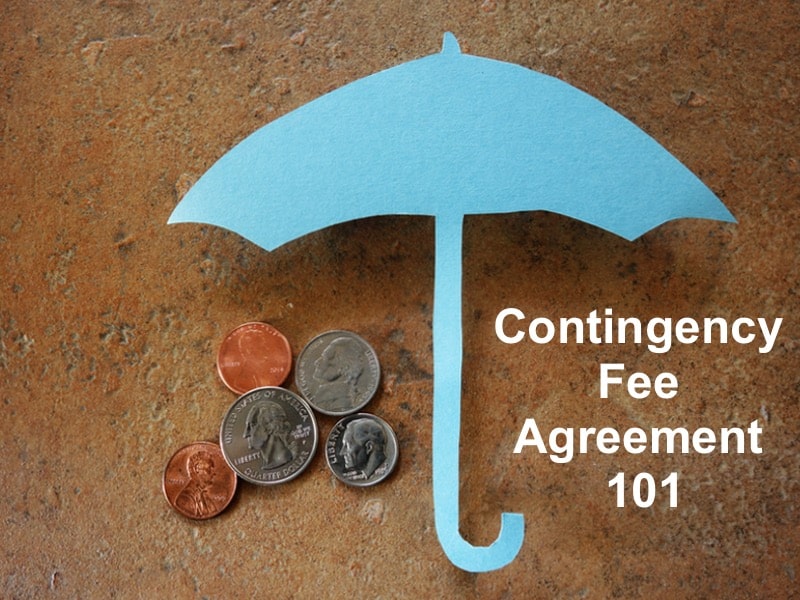A contingency fee agreement is a special type of contract that law firms use. It’s unique because the firm agrees that they only get paid if they win the case and win money for the client. The client agrees the lawyer’s fee will be a percentage of the funds collected. This arrangement allows a person to hire a lawyer without having to pay any money up-front or while the case is ongoing.
That’s the simple answer. In this article, I’ll go through it in more detail so you can better understand contingency agreements and how they work in Canada.
I’m writing as a lawyer who has worked almost exclusively with contingency fee agreements for the past fifteen years. Over this time, I have seen the good, the bad, and the ugly when it comes to contingency agreements. In fact, I resigned from one of my first jobs as a lawyer because I disagreed with the firm’s contingency fee agreement! I also have the unique experience of being licensed in several provinces, so I work with many different fee agreements.
Related reading:
Is There a Standard Contingency Fee Agreement?
One of the most common questions I get is whether there is a “standard” contingency fee agreement. The answer is that it depends on what province you live in. This is because contingency fee agreements are highly regulated by provincial law societies. These are the organizations that license and regulate lawyers in each province.
So, each province has its own set of rules for contingency fee agreements. These rules can be as simple as requiring certain clauses to be in the agreement. Or, they can be strict, like requiring all lawyers to use the same template agreement that’s approved by the law society.
For example, the New Brunswick Law Society has required all lawyers in the province to use the same template agreement for many years now. Ontario has also chosen to move in this direction. By July 2021, the Ontario Law Society will require all lawyers to use the same template. So, in New Brunswick and Ontario, as of July 1, 2021, you can expect all lawyers to use the exact same agreement.
In other provinces, contingency fee agreements vary from lawyer to lawyer. While they must all meet some basic criteria, they can vary quite a bit in terms of how the fees are calculated and the requirements for you to pay for expenses.
How are Contingency Fees Calculated?
Each contingency fee agreement outlines how the fee will be calculated. Normally, it’s a percentage of the fund collected by the lawyer on your behalf. So, if your lawyer negotiates a settlement of $100,000 with your insurance company, and the contingency fee is 33.3%, then the legal fee will be $33,300.
Alternatively, if the lawyer worked hundreds of hours on your case and the final settlement was only $10,000, then the legal fee would be only $3,330. The lawyer can never charge more than the maximum percentage set out in the agreement, even if that results in unfair compensation for the amount of work they did.
Finally, if the case is lost and no money is collected, the lawyer receives $0.
This is the nature of the contingency fee. The lawyer shares in your success, but you’re also protected if things go poorly.
Expenses not Included in the Contingency Fee Agreement
The contingency fee represents payment for the law firm’s work on your case. So, in the above example, $33,300 is paid for the lawyer’s work in negotiating the settlement. However, there are other expenses that are paid in addition to the lawyer’s work. These expenses are not included in a contingency fee. The two most common other expenses are the lawyer’s out-of-pocket expenses and sales tax on legal fees.
Lawyers’ out-of-pocket expenses are often referred to as disbursements. These are expenses paid to run the case. They include things like court filing fees, medical records fees, courier fees, and travel expenses. Lawyers will keep track of these expenses during the case. Many lawyers will advance the money to pay these expenses on your behalf. However, with some contingency agreements, the lawyer requires you to pay these expenses as the case moves along. This is a key difference that you should look for between law firms and their contingency fee agreements.
You also have to pay sales tax on legal fees. This often comes as a surprise. For the above example, where the legal fee was $33,300, imagine the sales tax is 13%. So, your total legal fee, plus taxes, is $37,629.
Buyer Beware
While I believe contingency fee agreements can be a win-win for the lawyer and client, you still need to protect your own interests. When crafting these agreements, lawyers are usually looking out for themselves. Remember when I said I resigned from a firm because I had a problem with their contingency fee agreement? While they weren’t doing anything that was technically illegal, I didn’t believe it followed the spirit and intent of the rules for that province.
This is why Ontario is moving towards a standard agreement that all lawyers have to use. Standard agreements take away any creative differences that lawyers may have. The intent is that it will allow consumers to be better protected. I totally agree with this. However, if you live outside of Ontario or New Brunswick, you should expect that each law firm will have a slightly different contingency fee agreement.
No one will look out for your interests better than you. So, you need to take time to educate yourself about the rules for contingency agreements in your province.
Next Step – Get Your Free Book
Start making better decisions today. Click on the image below to request an instant download of our free book on short- and long-term disability insurance claims.



